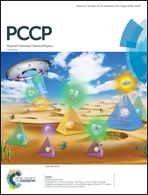Statistical thermodynamics unveils the dissolution mechanism of cellobiose†
Abstract
In the study of the cellulose dissolution mechanism opinion is still divided. Here, the solution interaction components of the most prominent hypotheses for the driving force of cellulose dissolution were evaluated quantitatively. Combining a rigorous statistical thermodynamic theory and cellobiose solubility data in the presence of chloride salts, whose cations progress in the Hofmeister series (KCl, NaCl, LiCl and ZnCl2), we have shown that cellobiose solubilization is driven by the preferential accumulation of salts around the solutes which is stronger than cellobiose hydration. Yet contrary to the classical chaotropy hypothesis, increasing salt concentration leads to cellobiose dehydration in the presence of the strongest solubilizer ZnCl2. However, thanks to cellobiose dehydration, cellobiose–salt interaction still remains preferential despite weakening salt accumulation. Based on such insights, the previous hypotheses based on hydrophobicity and polymer charging have also been evaluated quantitatively. Thus, our present study successfully paved a way towards identifying the basic driving forces for cellulose solubilization in a quantitative manner for the first time. When combined with unit additivity methods this quantitative information could lead to a full understanding of cellulose solubility.



 Please wait while we load your content...
Please wait while we load your content...